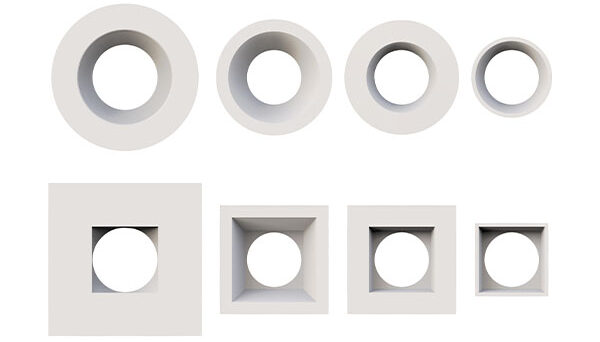Recessed lights are stylish yet functional forms of lighting. Installed within a ceiling, wall, or even a floor, people love them for their low-profile design.
Because they are hidden, they are a sleek way to brighten your space. Here are the basics of recessed lighting.
TYPES OF RECESSED LIGHTING
Recessed lights typically come in the form of downlights, but they can come in many different styles. Depending on your project, you might choose different types of light fixtures to blend into your ceiling. You can find recessed lighting in:
- Downlights
- Wallwashers
- Multiples
- Hallway Lights
- Recessed Track Systems
LED RECESSED LIGHTING COMPONENTS
There are four main parts that make up a recessed fixture.
Housing
What holds the light fixture in place in the ceiling.
Driver
Regulates the voltage and current
Cone and Trim
The visual portions of the fixture
LED Optic
What controls the light spread from the light-emitting diode
RECESSED LIGHTING HOUSINGS
A recessed light’s housing is what holds the light fixture inside of the ceiling, along with all the electrical components. It sits above the ceiling unseen. The type of housing you need is determined by fixture compatibility and construction type.
New-Construction Housing is typically used before the ceiling is installed in a new build.
Remodel Housing allows for recessed lighting to be installed into an existing ceiling.
IC-Rated Housing or “Insulation Contact” Housing is designed to allow direct contact with insulation. This type of housing is typically closed around the fixture to keep it from touching ceiling insulation, where it might become a fire hazard.
Non-IC Rated Housing or “Non-Insulation Contact” housing requires at least 3 inches of clearance between the fixture and the insulation. This housing is typically open, exposing the top of the fixture inside of the ceiling.
RECESSED LIGHTING TRIM TYPES

When you are looking up at the ceiling, the trim is the outer ring of the light fixture.
LED lighting is modern, efficient, and small. Therefore, it is best paired with a simple, basic trim. Most recessed LED lights come in round, square, and flangeless trims.
LED OPTICS
The optic is what you see in the inside of the cone where a bulb would be in incandescent lights. But LEDs operate in a totally different manner than traditional lighting.
Light-emitting diodes have a spread of 180 degrees as opposed to the traditional 360 degrees. Because of this, it requires a different optic to reflect light from the light-emitting diode.
High-quality LED fixtures will have a Total Internal Reflection or TIR optic. This allows for more control of where the light is emitting and will prevent glare.
RECESSED LIGHTING APERTURE SIZE
The aperture of a recessed light is the diameter of the inside cone. The aperture size you choose depends on where the fixture is located and how you plan to use it. Typical downlight aperture range from 1-6 inches.
LEDs technology has progressed so much that there are very tiny options that can produce a large amount of light output. Because of this, smaller lights are being used more often because of their sleek design.
RECESSED LIGHTING FINISHES
Recessed lighting is built to blend into surfaces, which means that the colors should as well. White, black, and silver trims are the most common colors used in recessed lighting.
That being said, most lighting manufacturers offer custom trim color options as well. For example, trim can be colored white while the cone can be black to reduce glare.
You can also choose fixture colors based on the hardware finishes you have in the space. Why not match those silver cabinet pulls with your silver lighting fixtures?
CHOOSING LIGHTING
Choosing lighting fixtures can be a fun project. However, it’s important to be aware of your location’s anatomy before purchasing any light fixtures.
Get advice from a professional to learn what parts are compatible with your project. If the project is too advanced, have your new lights installed by a qualified professional.



